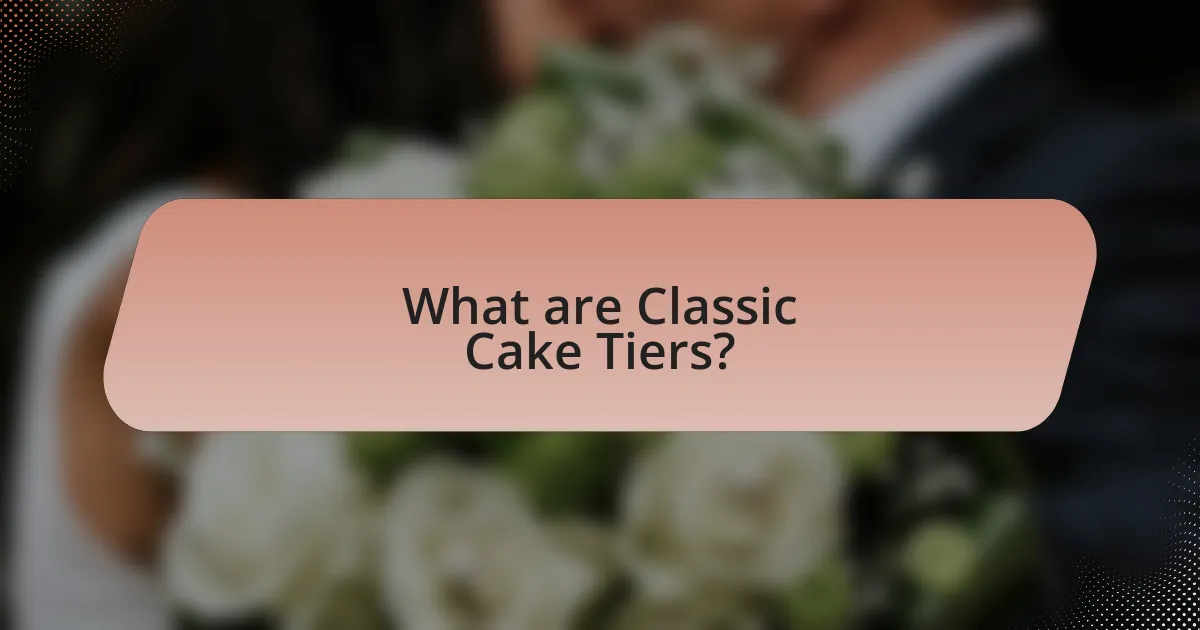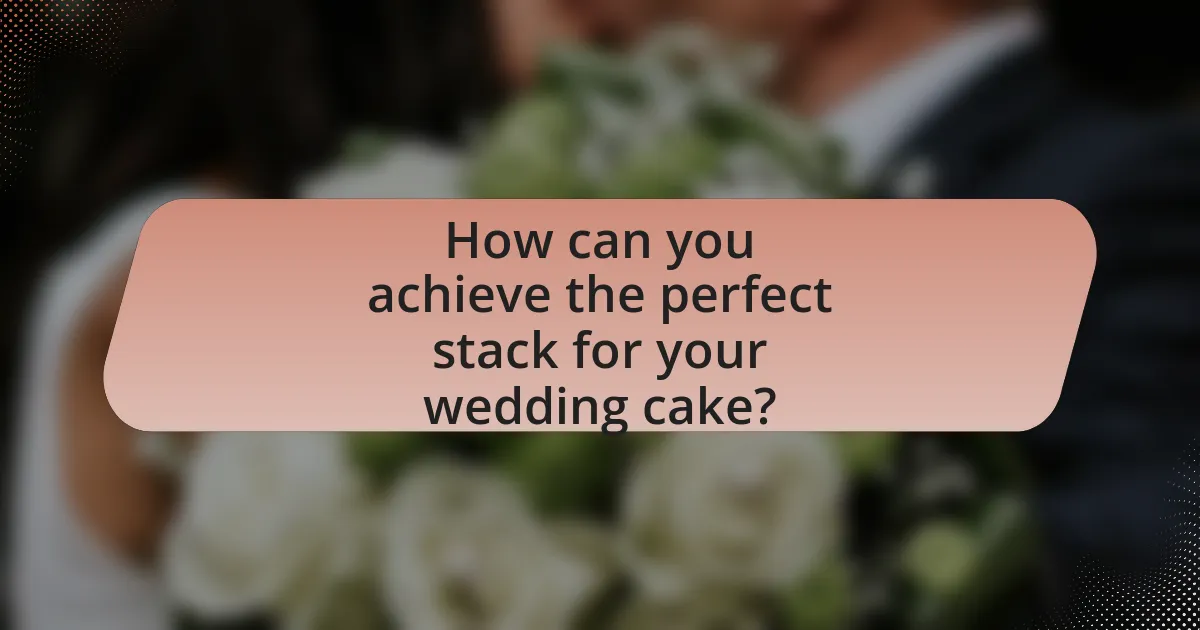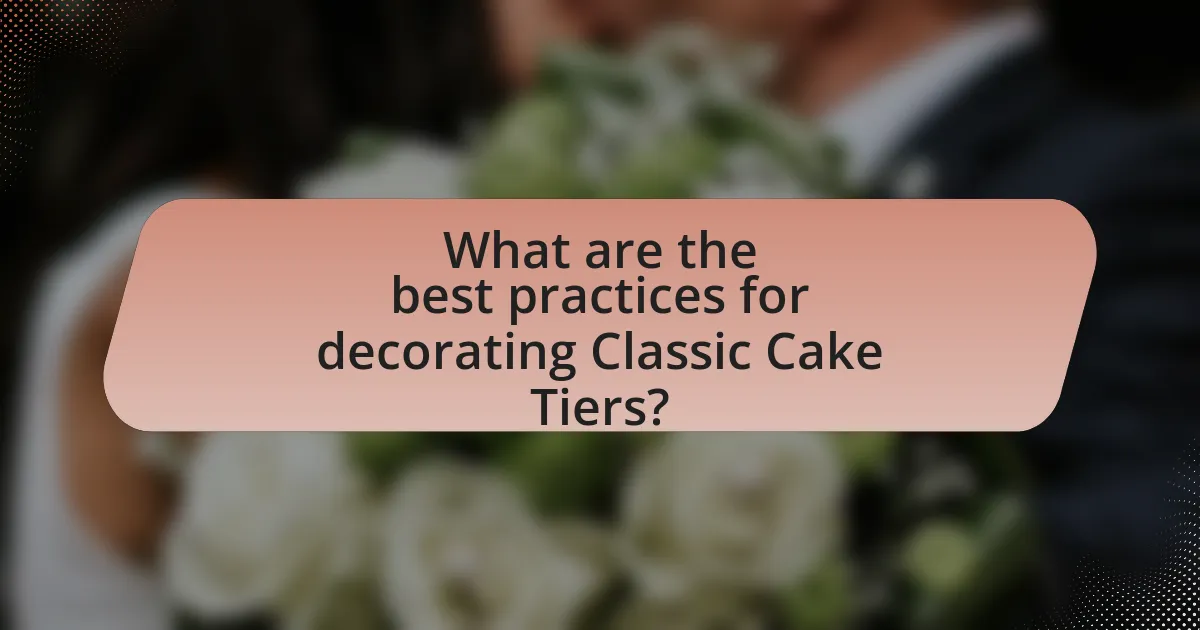Classic cake tiers are multi-layered cakes commonly used for weddings and special occasions, characterized by their distinct layers, each potentially featuring different flavors and decorations. This article explores the historical significance, structural differences, and traditional sizes and shapes of classic cake tiers, emphasizing their popularity for weddings due to their elegant presentation and variety of flavors. It also provides practical guidance on achieving a stable stack, including essential tools, common mistakes to avoid, and best practices for decoration, ensuring a successful and visually appealing wedding cake. Additionally, the article discusses how to incorporate personal touches and the importance of planning and logistics in cake design and transportation.

What are Classic Cake Tiers?
Classic cake tiers are distinct layers of cake stacked on top of one another, typically used in wedding cakes and special occasion cakes. Each tier is usually a different flavor or type of cake, and they are often decorated with frosting, fondant, or other embellishments to create an aesthetically pleasing presentation. The standard height for each tier can vary, but they are generally around 4 to 6 inches tall, allowing for a visually appealing and balanced structure. The use of classic cake tiers dates back to the 19th century, where multi-tiered cakes symbolized wealth and celebration, making them a popular choice for weddings and significant events.
How do Classic Cake Tiers differ from other cake styles?
Classic cake tiers differ from other cake styles primarily in their structured, multi-layered design, which is often used for formal occasions like weddings. Unlike single-layer cakes or non-tiered designs, classic cake tiers are stacked and supported by dowels or other structures to maintain stability and height. This tiered approach allows for a variety of flavors and fillings in each layer, catering to diverse guest preferences, while also providing a visually impressive centerpiece. The traditional aspect of classic cake tiers is reinforced by their historical significance in wedding ceremonies, where they symbolize prosperity and good fortune.
What are the traditional sizes and shapes of Classic Cake Tiers?
Traditional sizes of classic cake tiers typically include 6-inch, 8-inch, 10-inch, and 12-inch diameters. These sizes are commonly used in wedding cakes to create a visually appealing stacked effect. The shapes of classic cake tiers are predominantly round, although square and hexagonal shapes are also popular for modern designs. Round tiers are the most traditional and widely recognized, often used in multi-tiered wedding cakes to symbolize unity and celebration.
Why are Classic Cake Tiers popular for weddings?
Classic cake tiers are popular for weddings because they provide an elegant and traditional presentation that enhances the overall aesthetic of the celebration. The multi-layered structure allows for a variety of flavors and designs, catering to diverse guest preferences while also serving as a stunning centerpiece. Historically, tiered cakes symbolize prosperity and good fortune, making them a fitting choice for the significance of a wedding. Additionally, the versatility in decoration and the ability to customize each tier contribute to their enduring appeal in wedding traditions.
What materials are used in Classic Cake Tiers?
Classic cake tiers are primarily made from materials such as cake boards, dowels, and various types of cake, including sponge, buttercream, and fondant. Cake boards provide structural support, while dowels help stabilize the tiers, preventing them from collapsing. The choice of cake type affects both flavor and texture, with sponge cakes being light and airy, and buttercream cakes offering richness. These materials are essential for creating a visually appealing and stable cake structure, ensuring that the tiers hold their shape during display and serving.
How does the choice of cake flavor impact the tier structure?
The choice of cake flavor significantly impacts the tier structure by influencing the stability and weight distribution of the cake. Different flavors often require varying densities and moisture levels, which can affect how well the tiers stack and support each other. For instance, denser flavors like chocolate or fruitcake provide more stability, allowing for taller tiers, while lighter flavors such as sponge cake may necessitate additional support structures to prevent collapsing. Additionally, flavor combinations can dictate the need for different fillings and frostings, which further affects the overall weight and structural integrity of each tier.
What types of frosting and decorations are best for Classic Cake Tiers?
Buttercream frosting and fondant are the best types of frosting for Classic Cake Tiers. Buttercream offers a rich flavor and smooth texture, making it ideal for stacking and decorating, while fondant provides a sleek, polished finish that can be molded into intricate designs. Both options are widely used in wedding cakes, as they allow for various decoration styles, including floral arrangements, lace patterns, and elegant bows. The versatility of these frostings ensures that they can complement the overall aesthetic of the wedding theme, making them popular choices among bakers and couples alike.

How can you achieve the perfect stack for your wedding cake?
To achieve the perfect stack for your wedding cake, ensure each tier is level and supported properly. Use a sturdy cake board beneath each tier to provide stability and prevent sagging. Additionally, incorporate dowels or straws in the lower tiers to support the weight of the upper layers, which is essential for maintaining structural integrity. According to cake decorating experts, a well-constructed cake stack can prevent collapsing and maintain an aesthetically pleasing appearance throughout the event.
What are the essential steps for stacking Classic Cake Tiers?
To stack classic cake tiers, first ensure each tier is level and stable. Begin by placing a sturdy cake board under each tier to provide support. Next, use dowels or straws inserted into the bottom tier to create a stable base, ensuring they are cut to the same height as the cake. After that, carefully position the next tier on top, aligning it centrally. Repeat this process for additional tiers, ensuring each is secured with a bit of frosting or ganache to hold them in place. Finally, check the overall stability and adjust as necessary to prevent any leaning or shifting.
How do you ensure stability when stacking tiers?
To ensure stability when stacking tiers, use dowels or supports to reinforce each layer. Dowels, typically made of plastic or wood, are inserted into the lower tiers to provide a sturdy base for the upper tiers, preventing them from collapsing. Additionally, a sturdy cake board under each tier helps distribute weight evenly and maintains structural integrity. Properly leveling each tier during assembly is crucial, as uneven surfaces can lead to instability. These methods are widely recognized in professional baking, ensuring that multi-tiered cakes remain stable throughout transport and display.
What tools and supports are necessary for a successful stack?
A successful cake stack requires specific tools and supports, including cake boards, dowels, and a sturdy base. Cake boards provide a stable foundation for each tier, while dowels act as structural supports to prevent the tiers from collapsing under their weight. A sturdy base, such as a cake drum, ensures the entire structure remains stable during transport and display. These elements are essential for maintaining the integrity and aesthetic of the cake, especially for multi-tiered designs commonly used in weddings.
What common mistakes should be avoided when stacking cake tiers?
Common mistakes to avoid when stacking cake tiers include not using proper support, which can lead to structural failure, and failing to level the cake layers, resulting in an uneven appearance. Proper support, such as dowels or cake boards, is essential to distribute weight evenly and prevent collapsing. Additionally, leveling each tier ensures stability and a professional look. Not allowing the cakes to cool completely before stacking can also cause shifting and damage. Lastly, neglecting to secure the tiers with frosting or a dowel can lead to movement during transport.
How can improper stacking affect the overall appearance of the cake?
Improper stacking can lead to a visually unappealing cake, as misalignment and uneven layers create an unstable structure. When cake tiers are not stacked correctly, it results in a lopsided appearance, which detracts from the overall aesthetic and can make the cake look unprofessional. Additionally, gaps between layers can expose the filling and frosting, further diminishing the cake’s visual appeal. Proper stacking is essential for achieving a polished and elegant look, especially for significant events like weddings, where presentation is crucial.
What are the signs of a poorly stacked cake?
Signs of a poorly stacked cake include uneven layers, which can cause instability and leaning, and visible gaps between tiers, indicating improper alignment. Additionally, a poorly stacked cake may exhibit excessive frosting or filling oozing out, suggesting that the layers are not adequately supported. These issues can lead to structural failure, making the cake difficult to transport and present. Proper stacking techniques, such as using dowels for support and ensuring each layer is level, are essential to avoid these problems.

What are the best practices for decorating Classic Cake Tiers?
The best practices for decorating Classic Cake Tiers include ensuring a stable base, using high-quality ingredients, and employing a consistent theme throughout the design. A stable base is crucial; it can be achieved by using a sturdy cake board and dowels for support, which prevents the tiers from collapsing. High-quality ingredients, such as fresh butter and premium fondant, enhance both flavor and appearance, making the cake visually appealing and delicious. Consistency in theme, including color schemes and decorative elements, ties the tiers together, creating a cohesive look that aligns with the wedding’s overall aesthetic. These practices are supported by industry standards in cake decorating, which emphasize structural integrity, flavor quality, and visual harmony.
How can you choose a cohesive theme for your cake decoration?
To choose a cohesive theme for your cake decoration, first identify the overall style and color palette of your wedding. This alignment ensures that the cake complements the venue, floral arrangements, and other decor elements. For instance, if your wedding features a rustic theme with earth tones, opt for a cake design that incorporates natural textures and colors, such as a naked cake adorned with fresh flowers. Additionally, consider the flavors and ingredients that resonate with your theme; for example, a tropical wedding could feature a coconut or pineapple-flavored cake. By harmonizing the cake’s design, flavors, and colors with the wedding’s aesthetic, you create a unified visual experience that enhances the celebration.
What types of decorations complement Classic Cake Tiers?
Classic Cake Tiers are complemented by decorations such as fresh flowers, edible gold leaf, and intricate piping designs. Fresh flowers add a natural elegance and can be arranged to match the wedding theme, while edible gold leaf provides a luxurious touch that enhances the visual appeal. Intricate piping designs, often made from royal icing, can create detailed patterns that elevate the cake’s overall aesthetic. These decoration types are commonly used in wedding cakes, as they not only enhance the cake’s beauty but also align with traditional wedding aesthetics.
How can you incorporate personal touches into your cake design?
Incorporating personal touches into your cake design can be achieved by customizing elements that reflect the couple’s personality and story. This can include using specific colors that match the wedding theme, incorporating meaningful symbols or motifs, and selecting flavors that hold significance for the couple. For example, a couple might choose a cake flavor that was their favorite during their first date or add decorative elements that represent their shared hobbies or interests. Personalization not only enhances the visual appeal but also creates a memorable experience for the couple and their guests.
What tips can help ensure your wedding cake is a success?
To ensure your wedding cake is a success, select a reputable baker who specializes in wedding cakes. A skilled baker will have experience in creating structurally sound cakes that can support multiple tiers, which is essential for a classic stacked design. Additionally, communicate your vision clearly, including flavor preferences and design elements, to ensure the cake meets your expectations. It is also crucial to schedule a tasting session to confirm the flavors and textures align with your preferences. Lastly, consider the logistics of transportation and storage, as a well-prepared plan will prevent damage before the cake is served.
How far in advance should you plan your cake design and order?
You should plan your cake design and order at least 3 to 6 months in advance of your wedding. This timeframe allows sufficient opportunity for consultations with the baker, design finalization, and adjustments based on your preferences. Many professional bakers recommend this lead time to ensure availability and to accommodate any specific requests or customizations, which can take time to perfect. Additionally, booking early helps avoid last-minute stress and ensures that you secure your desired cake design for your special day.
What are the best ways to transport and store your cake before the event?
The best ways to transport and store your cake before the event include using a sturdy cake box for transportation and refrigerating the cake if it contains perishable ingredients. A well-constructed cake box protects the cake from damage during transit, while refrigeration helps maintain freshness and stability, especially for cakes with cream or fruit fillings. Additionally, securing the cake on a flat surface in the vehicle prevents movement, and using non-slip mats can further stabilize it. For storage, keeping the cake in a cool, dry place away from direct sunlight ensures optimal conditions until the event.
